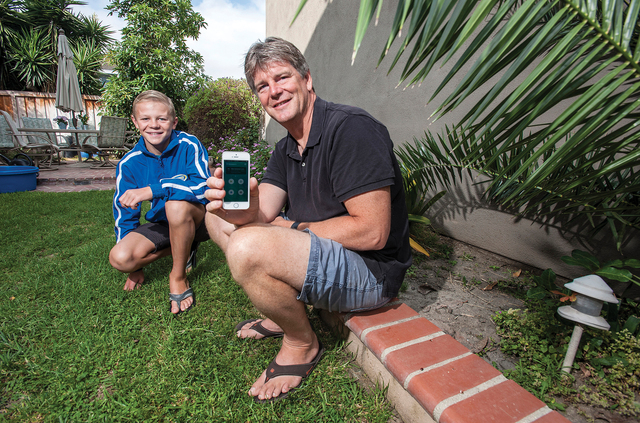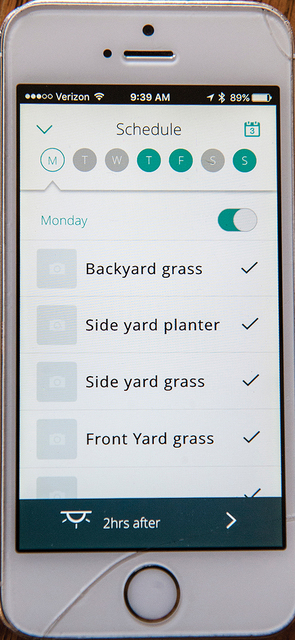Calif. tech firm develops ‘smart yard’ system to control watering with iPhone app, WiFi
IRVINE, Calif. — David Witting was enjoying July 4th fireworks with a few friends on his Irvine patio when, suddenly, his garden sprinklers went off.
“I didn’t miss a beat,” he recalled. “I didn’t have to rush into my garage with a flashlight to find the controller. I just pulled out my phone and turned them off in a second. It was pretty cool.”
Welcome to the “smart yard.”
Each of the five zones in Witting’s irrigation system can be adjusted from an app on his iPhone that connects to the controller in his garage. Through his home WiFi, the controller also pulls satellite and local weather data from the internet. It automatically turns off his sprinklers when it rains.
In Southern California, where the drought continues and water supplies are shrinking, such tech-friendly systems could be crucial to conserving enough water for a growing population. Up to 60 percent of residential water is used for irrigation and as much as half of that is wasted, according to the U.S. Environmental Protection Agency.
“We live in a modified desert,” said Witting, a fish biologist with the National Oceanic and Atmospheric Administration in Long Beach. “Yet I often see sprinklers running in the rain. It drives me crazy. Water is not something we should take for granted.”
Witting’s system, designed and manufactured by Blossom, an Irvine firm, is one of the latest inventions in the exploding universe of home automation. In the connected home, heating, air conditioning, lighting, alarm systems and appliances can be remotely controlled through software.
Globally, the home automation market, part of what’s known as the “internet of things,” or “iot,” is poised to grow at more than 14 percent a year over the next decade, according to an industry study. Revenue is expected to reach $117 billion by 2025.
“We are on the bleeding edge of an emerging technology,” said Blossom co-founder Kaido Kert, a former Microsoft engineer. “The internet of things is taking off and we are experimenting. It is exciting.”
Manrique Brenes, Blossom chief executive and co-founder, said the idea for a smart watering device came to him in 2012, when he moved from a small house in Corona del Mar to a bigger house in Laguna Beach. “Our water bill went from $60 a month to $160,” he recalls.
“But we were not showering any more than before. Then I saw the sprinklers go off when it was drizzling outside. So I called Kaido, and said, ‘What do you think?’”
Brenes, a Costa Rica native with masters degrees in engineering and in business from UC Davis, holds 14 patents covering home networking and industrial Ethernet applications. He had worked with Kert, a native of Estonia, at Skype and Microsoft.
“Traditional irrigation controllers are just timers,” Brenes said. “They go off on a given schedule. But plants consume water as a function of the weather. As it gets cooler, they need less. And if it rains your sprinklers should turn off. What we do is ‘smart watering.’”
With real-time weather data accessed through the cloud, watering in each section of a yard can be tailored to layout and vegetation.
The two colleagues began shipping Blossom’s first product, a 12-zone controller, in March 2015 after raising money through investors and a Kickstarter campaign.
The 12-zone model is sold at selected Home Depots, Best Buys and on line at myblossom.com, smarthome.com or Amazon. List price is $199, but smarthome discounts it to $150.
A smaller, more modest version, Blossom 8, which covers up to eight zones, launched last month. It is offered on Blossom’s website and on smarthome.com, with broader rollout planned over the next two months. List price is $129.
In California, where water is often priced in tiers with the higher tiers costing more, Blossom can lower homeowner bills by as much as 30 percent, the company estimates.
The controllers connect to existing wiring, valves and sprinklers. Most users say installation is easy, taking less than half an hour.
“I’m not much of a handyman,” wrote tech blogger Bryan Ruby in a recent review. “If you can read instructions and work a screwdriver, you should be able to master this install too.”
From the get-go, however, Blossom has faced competition. A Denver start-up, Rachio, sells a 16-zone smart water controller for $250. It can work with other smart-home systems such as the Nest Protect smoke alarm, turning on sprinkers when smoke is detected.
Rachio’s 16-zone device is more expensive as well as larger than Blossom’s 12-zone controller. And it garners superior reviews on Amazon: 4.5 stars out of a possible 5, as compared to Blossom’s 3 stars.
Recently, Rachio launched an 8-zone version for $200, which has also garnered 4.5 stars.
While many of Amazon’s Blossom reviewers have raved — “Best thing I did so far for my lawn,” wrote one verified purchaser in May — others complained of software glitches and a lack of updates to the app. Their sprinklers failed to turn off in the rain, or ran on for longer than programmed.
Brenes responded to several complaints on Amazon’s website. “We have been working very hard to reinforce the accuracy of our smart watering and clearly have a few remaining areas that we are addressing,” he wrote one critic in May.
“Much of our development has focused on our cloud-based infrastructure and we have returned to enhancing our Blossom App with new features.”
Witting, the Irvine biologist, is happy with his year-old system. “There were a few minor bugs that were worked out, like all systems have,” he said. “But it is pretty self-sustaining.
“It gives you a report on your smart phone. It will say something like, ‘Watering cycle canceled because of rain.’ And I’ve confirmed that it does cancel. Also, when it is hot and dry, it ramps up. If it is cool and overcast, it adjusts.
“It gives me peace of mind.”





